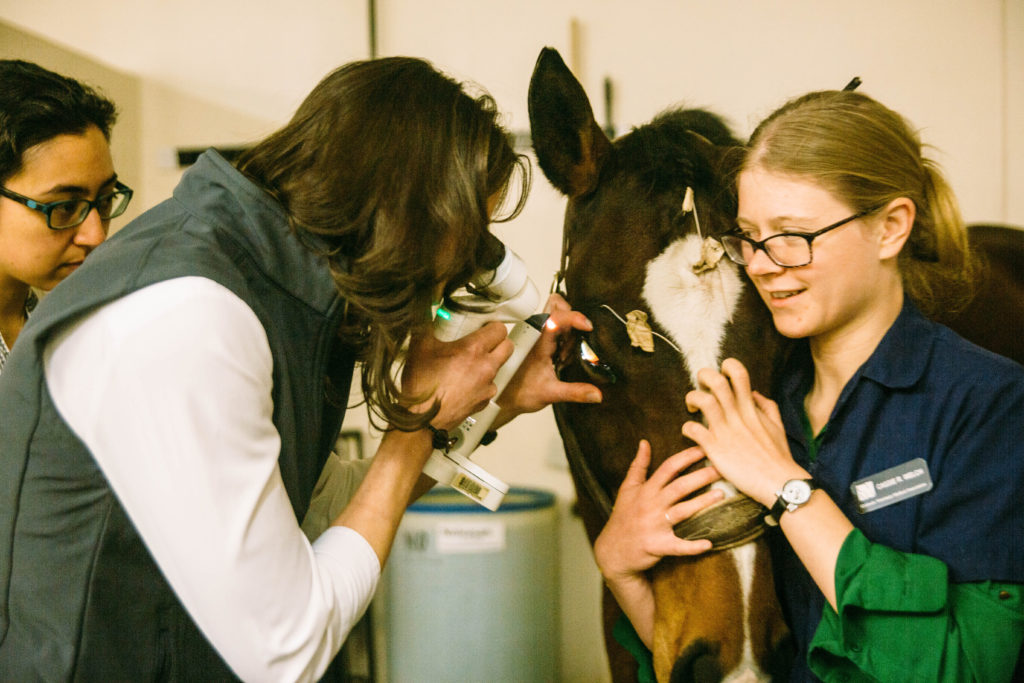
Ocular Squamous Cell Carcinoma Natural Animal Model
Description:
Ocular squamous cell carcinoma (SCC) is a form of neoplasia (e.g. cancer) affecting the eye of both animals and humans. Ocular SCC is relatively rare in humans, affecting 1 in 1,000,000 people in regions outside of Africa. Incidence is highest in Africa, due to increased rates of HIV and exposure to UV light, both of which are risk factors for development of ocular SCC (Gichuhi and Sagoo 2016). This form of neoplasia is especially common in horses and is the most common tumor affecting the equine eye and the second most common tumor in horses, following sarcoids (Morris Animal Foundation 2020). In both humans and animals, ocular SCC is often associated with vision loss and may require enucleation or removal of the eye to halt the spread of the cancer.
Similarities in Humans and Animals:
Ocular SCC has many similarities between humans and horses, including some risk factors for development of tumors, treatments available, and clinical response to treatment plans. Additionally, invasion of local tissue is observed in both horses and people, although the tumor is often slow to spread.
Differences in Humans and Animals:
Some differences exist between the clinical presentation of ocular SCC between animals and humans. In horses, the disease is often initially characterized by conjunctival or corneal hyperemia (or an excess of blood vessels in that region), which is followed by progression to a pink, raised mass. In humans, the tumor often presents as a progressive white growth on the surface of the eye.
Disease Etiology:
Several risk factors exist that increase the likelihood of developing ocular SCC, but like many tumors, the exact etiology is unknown. In people, development of ocular SCC is associated with HIV/AIDS, HPV, exposure to UV light, and allergic conjunctivitis. The highest incidence of ocular SCC in people occurs in Africa due to increased prevalence of HIV/AIDS and increased exposure to UV light, and ocular SCC in Africa often affects people around 40 years of age. Outside of Africa, ocular SCC most commonly affects older adults, with the average age being 60 years old, and is more common in males (Gichuhi and Sagoo 2016). Similar to humans, risk factors for horses include age (with the mean age being around 10), poor skin pigmentation and UV light exposure, and parasitic irritation of ocular tissue. Breed specific predispositions suggest that a genetic basis for the disorder may exist in horses (Knickelbein et al. 2020).
Clinical Presentation:
In humans, ocular SCC presents as a progressive white growth on the surface of the eye and is often marked by dilation of the surrounding blood vessels. Most lesions in people are on the conjunctiva with origins in the interpalpebral fissure. Symptoms of the condition often include red eyes, photophobia, irritation of the eye, or a foreign body sensation in the eye.
In horses, the lesion can occur on the nictitating membrane, conjunctiva, eyelid, or limbus. Equine ocular SCC initially presents with conjunctival or corneal hyperemia and progresses to a pink, raised mass. Symptoms in equine patients indicate irritation and include associated conjunctivitis and ocular discharge.
Treatment:
In both animals and humans, surgical excision is often the primary treatment for ocular SCC. However, in both species, recurrence of the tumor is very frequent after surgical excision. In addition, surgery is not always feasible as excision requires clear margins without making contact with the tumor. Enucleation is often required as the most definitive treatment. Many adjunct treatments have been developed in an effort to avoid enucleation.
Adjunct treatments for humans and equids include cryotherapy, radiation therapy, and chemotherapy (both injected and topical treatments). Immunotherapy treatments have also been developed for use in human patients in the past, including treatment with interferon α-2β. This molecule stimulates the immune system to destroy cancer cells, promotes apoptosis of affected cells, and has been successfully used to reduce the size of tumors and allow for surgical intervention in human patients. In an ongoing clinical trial at Colorado State University, researchers have used recombinant interferon α-2β to reduce the size of tumors affecting equid eyes, ultimately allowing veterinarians to perform surgical excision of the tumors in multiple cases.
INVESTIGATORS
—
Recent Publications
Galor A, Karp CL, Chhabra S, Barnes S, Alfonso EC. Topical interferon alpha 2b eye-drops for treatment of ocular surface squamous neoplasia: a dose comparison study. British journal of ophthalmology. 2010 May 1;94(5):551-4.
Kanaya R, Kase S, Ishijima K, Ishida S. Usefulness of Topical Interferon Alpha-2b Eye Drop as an Adjunctive Therapy Following Surgical Resection in Ocular Surface Squamous Neoplasia. in vivo. 2019 Nov 1;33(6):2211-5.
Meel R, Dhiman R, Sen S, Sharma S. Immunoreduction of locally advanced orbito-conjunctival squamous cell carcinoma with intraorbital interferon alpha-2b injection: a globe saving approach. Clinical & experimental ophthalmology. 2018 Jan;46(1):87.
Nava-Castañeda Á, Hernández-Orgaz J, Garnica-Hayashi L, Ansart A, Matus G, Tovilla-Canales JL, Zuazo F. Management of Ocular Surface Squamous Neoplasia with Topical and Intralesional Interferon Alpha 2B in Mexicans. Nepalese Journal of Ophthalmology. 2018 Dec 31;10(2):143-50.
Singh M, Gautam N, Kaur M. Role of topical interferon alpha-2b in ‘mitomycin-C-resistant’ocular surface squamous neoplasia: our preliminary findings. International Ophthalmology. 2019 Feb 15;39(2):295-301.
Venkateswaran N, Mercado C, Galor A, Karp CL. Comparison of topical 5-fluorouracil and interferon alfa-2b as primary treatment modalities for ocular surface squamous neoplasia. American journal of ophthalmology. 2019 Mar 1;199:216-22.
References
Cervantes G, Rodríguez Jr AA, Leal AG. Squamous cell carcinoma of the conjunctiva: clinicopathological features in 287 cases. Canadian journal of ophthalmology. 2002 Feb 1;37(1):14-20.
Estell K. Periocular Neoplasia in the Horse. Veterinary Clinics: Equine Practice. 2017 Dec 1;33(3):551-62.
Galor A, Karp CL, Chhabra S, Barnes S, Alfonso EC. Topical interferon alpha 2b eye-drops for treatment of ocular surface squamous neoplasia: a dose comparison study. British journal of ophthalmology. 2010 May 1;94(5):551-4.
Gichuhi S, Sagoo MS. Squamous cell carcinoma of the conjunctiva. Community eye health. 2016;29(95):52.
Knickelbein KE, Lassaline ME, Singer‐Berk M, Reilly CM, Clode AB, Famula TR, Michau TM, Bellone RR. A missense mutation in damage‐specific DNA binding protein 2 is a genetic risk factor for ocular squamous cell carcinoma in Belgian horses. Equine veterinary journal. 2020 Jan;52(1):34-40.
Meel R, Dhiman R, Sen S, Sharma S. Immunoreduction of locally advanced orbito-conjunctival squamous cell carcinoma with intraorbital interferon alpha-2b injection: a globe saving approach. Clinical & experimental ophthalmology. 2018 Jan;46(1):87.
No Horsing Around with Cancer [Internet]. Morris Animal Foundation. 2020 [cited 2020Jun29]. Available from: https://www.morrisanimalfoundation.org/article/no-horsing-around-cancer
Rayner SG, Van Zyl N. The use of mitomycin C as an adjunctive treatment for equine ocular squamous cell carcinoma. Australian veterinary journal. 2006 Jan;84(1‐2):43-6.
Santoni A, Thariat J, Maschi C, Herault J, Baillif S, Lassalle S, Peyrichon ML, Salleron J, Caujolle JP. Management of invasive squamous cell carcinomas of the conjunctiva. American journal of ophthalmology. 2019 Apr 1;200:1-9.
Schwink K. Factors influencing morbidity and outcome of equine ocular squamous cell carcinoma. Equine Veterinary Journal. 1987 May;19(3):198-200.



